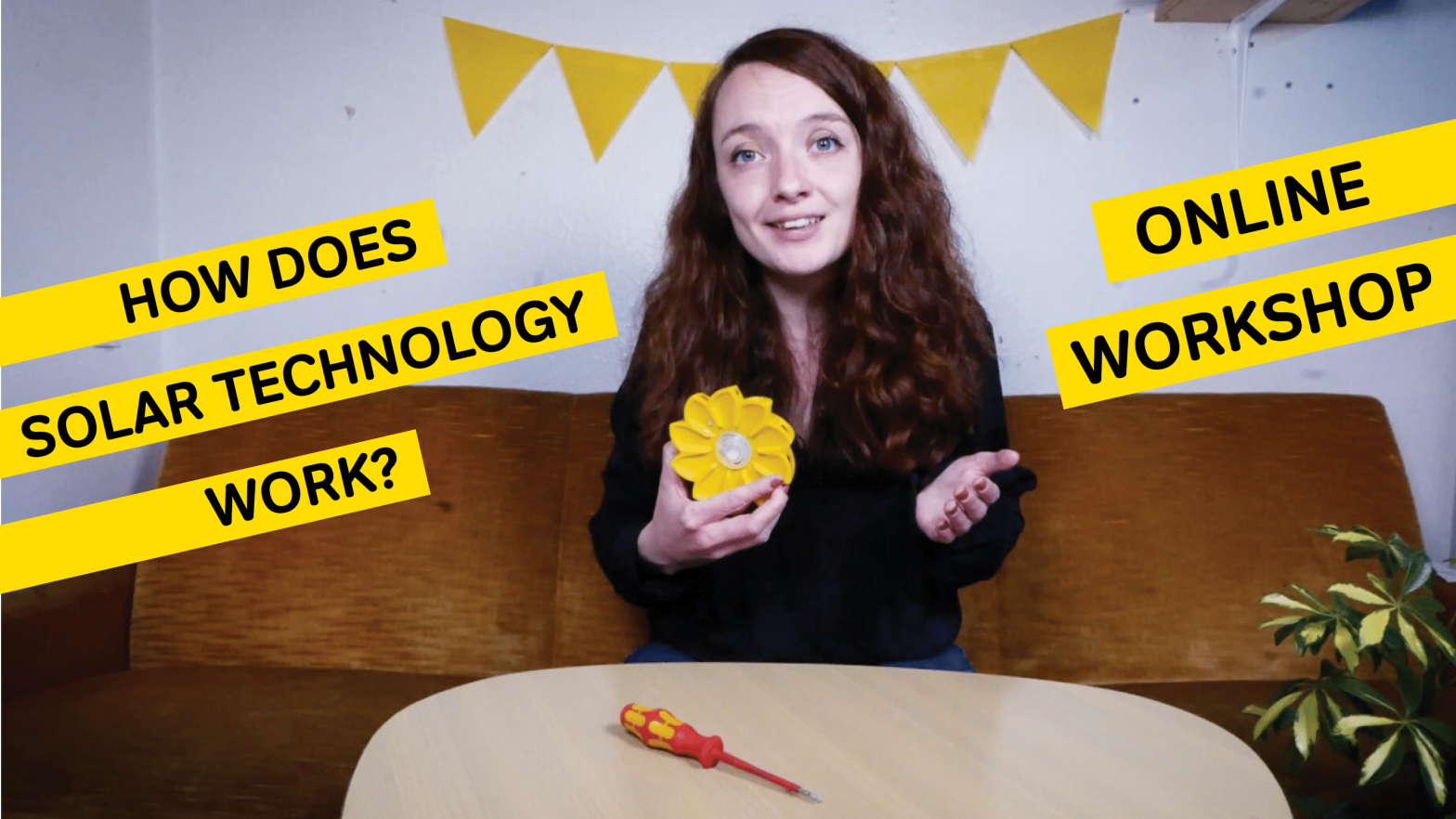What are the components of a solar lamp? How can we harness the power of the sun and turn it into light? This is what we will discover in this online workshop by taking apart a Little Sun solar lamp and learning about every component inside. We will explain everything to you the whole solar technology inside of the lamp, so that you can become a solar master and tell your friends about the benefits of solar.
Watch this video or read the steps below!
Warning: the solar lamp includes a battery. If you want to proceed with this workshop, make sure you have an adult around you. When you put the battery back inside the Little Sun, make sure you put the right poles (+ and -) fit into the lamp. Otherwise, it will create a short circuit, meaning that the electricity does not go the right way and the lamp will not be working.
What you need for this workshop:
- a Little Sun Original
- a Tx9 screwdriver
- a bit of elbow grease

This workshop is aimed for children between 8-12 years old.
I. PRAXIS
1. Open up the solar lamp
This takes a bit of time, but is fairly easy. On the backside, you can see a black square and four holes around it. Each hole contains a little screw. Insert the screwdriver in each hole and take out the screws. As soon as you find the tipping point, rotate the screwdriver counter clockwise. When you feel the screws are loose, you can stop. Now, you can put the screwdriver on the side, you will need it later to reassemble the lamp.

2. Gently dismantle the lamp
After taking the screws out, you are now able to take apart the lamp. Gently pull apart the lamp and put all the components in front of you. You should end up having these parts in front of you:

Are there parts of the lamps you can recognize already? Take a few minutes to flip them around and try to understand what is the purpose of each component and how they all work together.
Now, let’s review all the elements together!
The battery
We know batteries already from our everyday life, in a remote controller, for example. In a solar lamp, batteries are used for storing the energy converted by the solar panel. When the battery is full, the charging stops. The battery used in the Little Sun is a AA LiFePO4, 3,2V rechargeable battery with 500 mAh.
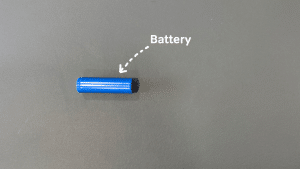
The case
The case protects all the components inside, e.g. the battery and the electronics from water, dust, and other environmental damage. We use recyclable ABS plastic, which is robust, durable, and UV-resistant. This gives people the opportunity to enjoy solar energy for the longest time possible! Check how robust it is, even when it falls down.
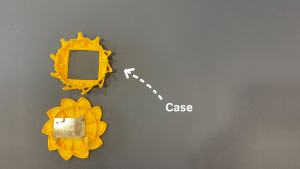
The solar panel
The solar panel features photovoltaic cells, which capture the energy of the sun and convert it into electricity. The solar panel is made from a printed circuit board with the solar cells mounted on top and connected to a circuit. These elements are then glued together with a metal layer and baked in an oven. It is 60 x 60 millimeters big and the solar cells are made out of silicon. Their longevity is impressive! It can last over 25 years.

The PCB
PCB stands for Printed Circuit Board. You can find them in a lot of electronic items, such as computers. This electrical circuit works as the middlemen between the solar panel, the LED, and the battery. The printed little pathways connect all the components of the PCB and allow the electricity to circulate to the LED or to the battery. It also works like a mini computer if you want to use the dimmer function of the lamp, making different light levels possible.
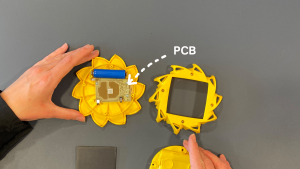
The LED
The LED is the Light Emitting Diode, this is the part that allows you to produce light at night. The lumen output of the LED is different if you push longer on the on/off button: with a full charge, you can get four hours of bright light (30 lumens), or up to fifty hours at the lowest level (2 lumens). Lumens are the international unit to measure the light output of a lamp.
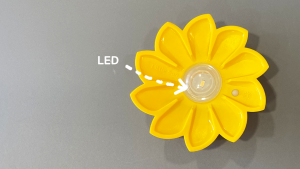
3. Time to experiment!
Now, we will make two experiments to see how the components are interconnected so that it allows the solar lamp to work effectively. Follow the steps and try to figure out why the lamp works or not. In each experiment, you will be able to deduce the role of each component, understanding which ones are connected and work together.
- For the first experiment, we will leave out the batteries and put back the lamp together. When you mount it back, make sure to connect the two metal strings attached to the PCB to the metal dots on the solar panel. You do not need to put the screws back in, just make sure to hold all the parts tight. Now, go to your window or outside and point the solar panel to the sun. Turn on the light and see what happens!
What happens when the battery is out but the solar panel is facing the sun? (click to unroll)
The solar lamp will work if the sun is shining. If it is cloudy, the lamp will be blinking, meaning that it still receives some sunlight, but the quantity is reduced. If there is no sun at all, the solar lamp will not be working at all.
Conclusion: Even without battery, the solar lamp can still work if it gets direct sunlight. This means the battery plays a huge role by storing the energy collected during the day. It also means the PCB leads the electricity generated by the solar panel directly to the LED.
- For the second experiment, we will put the battery back in (watch the + and the -) and leave out the solar panel. Warning: make sure the two poles are connected at the right place, you have to see where the plus and the minus are and make them fit at the right place. Otherwise, it will create a short circuit, this means the electricity does not move in the right direction, and the system will not be working. Turn on the light and see what happens!
What happens when you turn on your light after putting back the battery? (click to unroll)
It works, even without the solar panel. However, when the batteries run out of energy, you won’t have light anymore. This means you need the solar panel to collect the energy, which then will be stored in the battery. This time, the PCB makes the electricity run from the battery to the LED. This means the PCB can lead the electricity to the LED whether from the solar panel directly, or from the battery.
As you just saw, all the components of the lamp are needed to have reliable and clean light at night, using energy stored during the daytime. The lamp will not work properly if one component is missing.
4. Reassemble the lamp
Putting back the lamp together is as easy as dismantling it! You just have to watch out putting the battery back in the right way (watch the – and the +). Afterwards, put back the middle case in, making sure the two metal strings connected to the PCB come out. Put back the solar panel, connecting the two metal dots to the two metal strings. To finish, put the flower-shaped case on the top and put the screws back in. With the screwdriver, turn clockwise until it is tightly closed. Voilà, your lamp is back up and running!
II. Theory & sum-up
Solar energy
Let’s recap how solar technology works. The sun releases photons, which are light particles. These photons take 8 minutes and 20 seconds to reach the Earth, they can then be captured by the solar cells! The solar cells, made of silicon, conduct the particles that are converted into clean electricity that can be stored into the batteries through the two metal strings. When you turn on your solar lamp, the LED will emit light, so that you can use the energy you gathered from the sun during the day.
Renewable energy
Humans have invented various technologies for harnessing the energy that we use for powering many of the things around us, such computers, cars, and solar lamps! Some of those sources of power are renewable and others are not. Non-renewable energy sources are limited. This means that when we run out of these sources of energy, it is not possible to get power anymore. They include coal, oil, natural gas.
There are however other sources of energy that are limitless on Earth, grouped under the umbrella of renewable energy. It includes solar, wind, or even waves! As they are infinite, this means we will always be able to take advantage of them.

In remote areas of Africa, families use kerosene lamps for lighting when the sun goes down. Kerosene is a limited source of energy, is very dangerous for both the health and the environment, and may cause house burns. Providing a solar lamp to families living without access to electricity is a great solution! Children can play and study safely after dark, babies can be delivered safely, and individuals can keep socializing. Instead of using a non-renewable source of energy, they can use free and limitless power from the sun, which means they can produce energy at no cost. This is why it is so important that everyone in this world should have access to clean, affordable, and reliable energy.
Also, did you know that the amount of power from the sun that reaches the Earth in one hour is more than the entire world consumes in a year? So, let’s go solar!
Our workshop has now come to an end, we hope you enjoyed it! Subscribe to our YouTube channel if you would like to have more solar fun, and check out our website for other fun activities! Would you like to learn something in particular? Tell us in the comments!

